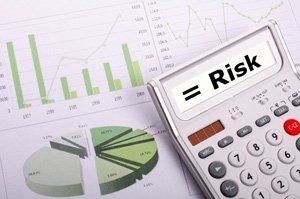Editor's Note: Risk management is your best defense against total loss, which is why it's a core component of Keith's Total Wealth method. Today we're revisiting one of his favorite risk-limiting strategies: position sizing. Here's Keith...
There's an old joke that's made its way around financial circles over the years. It goes something like this...
An investment banker walks into a room where his cohorts are in a meeting. "I've got good news and bad news," he announces. "The bad news is, we've just lost $100 million. The good news is, it wasn't ours." An associate raises his hand. "What was the bad news again?"
It's humor, but there's more than a grain of truth to the story. Whether we're talking about brokers, bankers, or even your most trusted financial advisor, you cannot rely on anyone else to care about your money and keep it safe.
At the end of the day, the only thing standing between your portfolio and catastrophic loss is your own caution and proper risk management.

I know it's not the most exciting part of investing. But there's zero doubt in my mind it is the most important.
That's why it's the third part of my Total Wealth strategy.
And one tool called "position sizing" stands out above all others as the most powerful, and not just for cutting risk, but for boosting your profits, too.
To see what I mean, consider this anecdote from trading psychologist Dr. Van Tharp:
We've done many simulated games in which everyone gets the same trades. At the end of the simulation, 100 different people will have 100 different final equities. And after 50 trades, we've seen final equities that range from bankrupt to $13 million - yet everyone started with $100,000, and they all got the same trades. Position sizing and individual psychology were the only two factors involved - which shows just how important position sizing really is.
Here's how I recommend you start using it right now...
Position Sizing: The Single Most Powerful Risk Management Tool of All
If you've never heard the term, don't worry. You're not alone. In 30-plus years I've run across a lot of seasoned professionals who have a hard time explaining exactly what position sizing is, let alone why it can lead to bigger profits.
Yet the concept is actually really simple - controlling the amount of money you place in each trade can lead to bigger profits and mitigate the risk of a catastrophic loss.
While there are a lot of things to like about position sizing, there are two elements I find particularly compelling:
- You never have to worry about a large chunk of your capital getting vaporized; and,
- You implement this risk management tool before you invest a single penny, which automatically boosts your probability of profit.
It's one of the single most important concepts any investor can learn... or relearn...
Don't Get Caught by This Beginner's Mistake
Many investors start out by swearing to themselves that they won't risk a penny more than a certain amount on any trade. That there's a line they won't cross, no matter how glittering of an opportunity they face or how caught up in the moment they are. The major problem with this is that very few investors see the plan the entire way through.
In theory, they apportion no more than 10% (or whatever the figure they deem appropriate) to the risky stocks that they hope will become home runs. But it's a difficult commitment to stick to at times. Many an investor has allowed himself to make an exception just for this one stock and gotten burned.
Other times, an investor might stay true to her commitment to never expose more than 15% of her portfolio to riskier stocks. But she puts 10% of her capital into an exciting company that's nonetheless a flash in the pan and takes a big hit to her portfolio - despite staying true to her original risk guidelines.
The worst offenders by far though are the investors who bet the ranch on a stock, even one they've thoroughly researched, and who end up with nothing. And while that's sad to see, many millions of investors hurt themselves with minor-seeming positioning mistakes that their portfolios nonetheless take months or even years to recover from.
What these investors don't understand is the science of managing and controlling risk, eliminating it wherever possible. And that brings us back to position sizing.
Position sizing is the science of cutting risk in your portfolio down to the bone. It answers the question: "How big should I make my position for any one trade?"
Many investors think they have this covered with trailing stops that take them out of an investment when some predetermined limit is hit. Usually, it's a percent loss or a dollar figure.
Position sizing is different. It's about determining how much of something you can buy for maximum profits or if you can even afford to buy in the first place.
Three Methods for Sizing Your Positions
[mmpazkzone name="in-story" network="9794" site="307044" id="137008" type="4"]
First, the simplest method - and a good rule of thumb - is to make sure you have no more than 2% of your risk capital at stake in any single recommendation. Even if you never think about position sizing again, this is a great place to start.
For an investor with $100,000, that would be buying no more than $2,000 worth of any given stock. If 100 shares cost $5,000, then either you've got to buy fewer shares or find another stock at a less expensive price.
The advantages to this model are simplicity and the fact that you can use it even with far smaller sums of money. The disadvantages are that there's no accommodation for different types of investments and small accounts can get overexposed if you're not careful.
Second, other traders prefer the "percent risk" model. This means they are taking positions and using the overall change in value as a function of the risk they can withstand.
With only three variables, the "percent risk position sizing" formula is clear and concise. Best of all, it serves as a great indicator for the appropriate amount of risk for you to take on... whether you're a seasoned and successful investor or someone who's just getting started.
Here's the formula:
Dollar Risk Size / (Buy Price - Stop Price)
So for example, let's say you want to buy a $20 stock with an $18 stop loss, and the maximum amount you've resolved to risk is $2,000. The formula suggests you buy 1,000 shares.
This model is great for long-term investors and trend followers, in particular. That's because it regards the risks associated with each trade equally.
Third, another way to do it is to adjust risk according to volatility.
This gets a little more sophisticated, but here's the formula:
Position Size = (CE * %PE) / SV
CE is the current portfolio size. %PE is the percentage of portfolio equity that a trader is prepared to risk per trade. SV is volatility over some predetermined range like the preceding 10 trading days, for instance.
If a trader with a $100,000 portfolio is prepared to risk 2% of total equity and the volatility is $1.50 over the past 10 days, the result is 1,333 shares initially. However, as volatility drops, a trader using this model would add to positions. As volatility rises, he would cut back. In other words, you can't just set it and forget it with this method.
The percent volatility model is fabulous for those who like tight stops because it can provide a flexible balance between opportunity and the risk needed to capture it. It's also adjustable.
Obviously, we've just scratched the surface. There are literally thousands of position sizing models you can choose from that accommodate everything from liquidity to personal risk tolerances, currencies, expectancy, and more.
My point is that you can make position sizing as complicated as you want or as simple as you need.
My preference is for "simple" every time, for one reason... you never want to play the game if you don't have the cash to back it up.
Understanding position sizing puts you miles ahead of other investors who spend their time wondering what to buy while ignoring the critical question of how much.
Risk management is the core of Keith's Total Wealth strategy, but it's just one of the tactics he recommends. To get access to all his strategies, stock recommendations, and market analysis, click here. You'll get his Total Wealth delivered straight to your inbox every week, free of charge.
Don't Miss These Fast, Monstrous, Accelerating Gains
I'm showing readers how to cash in on a series of lucrative partial and full plays generating over 80 triple-digit winners...
...and average weekly gains that began at 59% last year... and quickly grew to 127%... then 210%... then 313% in October.
What's next? For the sake of your own wealth, you need to see this...
About the Author
Keith is a seasoned market analyst and professional trader with more than 37 years of global experience. He is one of very few experts to correctly see both the dot.bomb crisis and the ongoing financial crisis coming ahead of time - and one of even fewer to help millions of investors around the world successfully navigate them both. Forbes hailed him as a "Market Visionary." He is a regular on FOX Business News and Yahoo! Finance, and his observations have been featured in Bloomberg, The Wall Street Journal, WIRED, and MarketWatch. Keith previously led The Money Map Report, Money Map's flagship newsletter, as Chief Investment Strategist, from 20007 to 2020. Keith holds a BS in management and finance from Skidmore College and an MS in international finance (with a focus on Japanese business science) from Chaminade University. He regularly travels the world in search of investment opportunities others don't yet see or understand.



